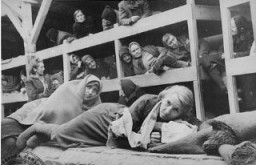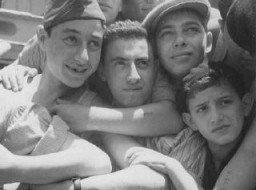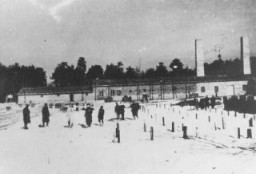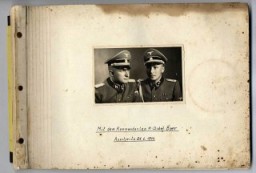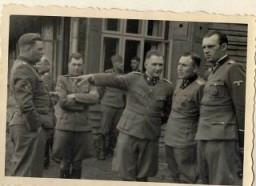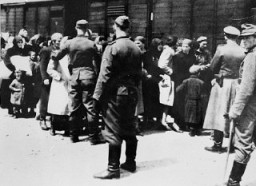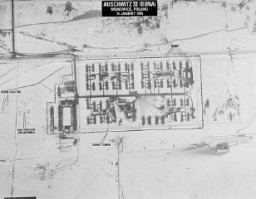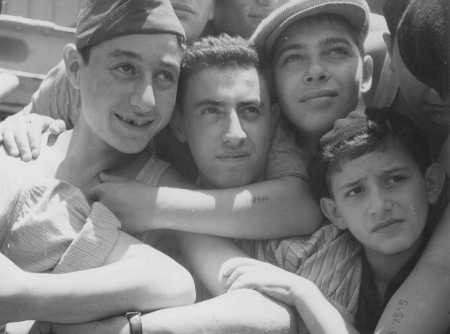
Tattoos and Numbers: The System of Identifying Prisoners at Auschwitz
During the Holocaust, concentration camp prisoners received tattoos only at one location, the Auschwitz concentration camp complex. The Auschwitz camp complex consisted of Auschwitz I (Main Camp), Auschwitz II (Auschwitz-Birkenau), and Auschwitz III (Monowitz and the subcamps).
Assignment of Camp Serial Numbers and the Introduction of Tattooing
Incoming prisoners were assigned a camp serial number which was sewn to their prison uniforms. Only those prisoners selected for work were issued serial numbers; those prisoners sent directly to the gas chambers were not registered and received no tattoos.
Initially, the SS authorities marked prisoners who were in the infirmary or who were to be executed with their camp serial number across the chest with indelible ink. As prisoners were executed or died in other ways, their clothing bearing the camp serial number was removed. Given the mortality rate at the camp and practice of removing clothing, there was no way to identify the bodies after the clothing was removed. Hence, the SS authorities introduced the practice of tattooing in order to identify the bodies of registered prisoners who had died.
Just before I turned 6, my family was deported to Auschwitz from the Theresienstadt ghetto. My arm was tattooed with the number 169061. There, I was separated from my sister and mother and put into a barracks with older boys—many seemed to be twins.
—Rene GuttmannThere was one person who would rub the...a little piece of dirty alcohol on your arm, and the other one had the...had the needle with the inkwell, and he would do the numbering. So my number is 65,316.
—Miso (Mike) Vogel

Method of Tattooing
Originally, a special metal stamp, holding interchangeable numbers made up of needles approximately one centimeter long was used. This allowed the whole serial number to be punched at one blow onto the prisoner's left upper chest. Ink was then rubbed into the bleeding wound.
When the metal stamp method proved impractical, a single-needle device was introduced, which pierced the outlines of the serial-number digits onto the skin. The site of the tattoo was changed to the outer side of the left forearm. However, prisoners from several transports in 1943 had their numbers tattooed on the inner side of their left upper forearms. Tattooing was generally performed during registration when each prisoner was assigned a camp serial number. Since prisoners sent directly to the gas chambers were never issued numbers, they were never tattooed.
Adoption of Tattooing Throughout the Auschwitz Complex
The first prisoners to be tattooed were Soviet prisoners of war who were brought to Auschwitz, beginning in October 1941, for forced labor. The following month, the SS made the decision to tattoo these prisoners. Because of mistreatment, starvation, and disease, almost all these 10,000 Soviet prisoners died within months of arrival.
In spring 1942, the SS began systematically tattooing all incoming Jewish prisoners. This form of identification also was applied to very ill prisoners, predominantly Poles, who had been transferred from the camp hospital at Auschwitz I to the newly constructed camp at Birkenau (Auschwitz II). In early 1943, the practice of tattooing prisoners at the Auschwitz camp complex expanded. Following the escape of a female Polish prisoner in February, the Camp Commandant’s Office decided that all incoming prisoners would henceforth be tattooed on the lower left arm. Prisoners who had already been registered in the camp complex also were tattooed.
Certain categories of prisoners, however, were exempt from the tattooing process. It did not apply to German prisoners, ethnic German inmates, police prisoners, or “labor-education prisoners.” The latter group was composed of non-Jewish persons from various nationalities, but primarily Germans, Czechs, Poles, and Soviet civilians, who had been imprisoned for failing to adhere to the harsh discipline imposed on civilian laborers in German-occupied areas. Such inmates, in theory, were to be detained for up to 56 days and forced to work no less than 10 hours a day to “re-educate” them. In addition, Polish civilians deported to Auschwitz after the Warsaw Uprising in 1944 were not tattooed. Some Jewish prisoners who were held in transit to other camps did not have to undergo this procedure.
Prisoner Numbers
The first series of prisoner numbers was introduced in May 1940, well before the practice of tattooing began. This first series was given to male prisoners and remained in use until January 1945, ending with the number 202,499. Until mid-May 1944, male Jewish prisoners were given numbers from this series.
A new series of registration numbers was introduced in October 1941 and remained in use until 1944. Approximately 12,000 Soviet POWs were given numbers from this series (some of the POWs murdered at Auschwitz were never registered and did not receive numbers).
A third series of numbers was introduced in March 1942 with the arrival of the first female prisoners. Approximately 90,000 female prisoners were identified with a series of numbers created for female prisoners in March 1942 until May 1944.
Each new series of numbers introduced at Auschwitz began with “1.” Some Jewish prisoners (but not all) had a triangle tattooed beneath their serial number.
In order to avoid the assignment of excessively high numbers from the general series to the large number of Hungarian Jews arriving in 1944, the SS authorities introduced new sequences of numbers in mid-May 1944. This series, prefaced by the letter A, began with “1” and ended at “20,000.” Once the number 20,000 was reached, a new series beginning with “B” series was introduced. Some 15,000 men received “B” series tattoos. For an unknown reason, the “A” series for women did not stop at 20,000 and continued to 30,000.
A separate series of numbers was introduced in January 1942 for “reeducation” prisoners who had not received numbers from the general series. Numbers from this new series were assigned retroactively to “reeducation” prisoners who had died or been released, while their superseded general-series serial numbers were reassigned to new “general” arrivals. This was the only instance in the history of Auschwitz of numbers being “recycled.” Approximately 9,000 prisoners were registered in the “reeducation” series. Beginning in 1943, female “reeducation” prisoners were given serial numbers from their own new series, which also began with “1.” There were approximately 2,000 serial numbers in this series.
Beginning in February 1943, SS authorities issued two separate series' of number to Romani (Gypsy) prisoners registered at Auschwitz: one for the men and one for the women. Through August 1944, 10,094 numbers were assigned from the former series and 10,888 from the latter. Romani prisoners were given the letter Z (“Zigeuner” is German for "Gypsy") in addition to the serial number.
The camp authorities assigned more than 400,000 prisoner serial numbers (not counting approximately 3,000 numbers given to police prisoners interned at Auschwitz due to overcrowding in jails who were not included in the daily count of prisoners).
Series: Auschwitz
Critical Thinking Questions
- Why did the SS tattoo a number on some prisoners?
- Investigate the impact that the process of tattooing had on some prisoners.
